The Windows Phone 7 Review
by Anand Lal Shimpi & Brian Klug on October 20, 2010 7:00 PM EST- Posted in
- Smartphones
- Windows Phone 7
- Microsoft
- Mobile
Introduction
This isn’t going to be a story about Microsoft’s return to dominance. Nor is it going to be the story of Microsoft’s failure to compete in the smartphone space. These mobile wars have only just begun and despite the advantage enjoyed by Apple and Google, there is no end in sight. In another twelve months we will see fierce competition from HP, Microsoft and Nokia. There’s a lot at stake, and no company is willing to give up the opportunity to own the next-PC market without a hell of a fight. Today is the beginning of Microsoft’s fight.
In the old days, when Microsoft tried to deliver a prettier UI it would just add lots of blue and make everything huge. That’s how we got XP. We never really lost the blue or hugeness, they were just made more refined through the years.
Windows Phone 7 is a significant departure from anything Microsoft has ever done in the past, from a UI standpoint that is. In my opinion it’s more beautiful than anything else on the market today - including Apple’s iOS. That’s a big statement for anyone to make about Microsoft, a company that has tried so very hard to prevent Apple’s increasing market share but always seemed to be at least one step behind in the user experience department. The Windows Phone 7 user experience is a big enough step forward to not only build a lot of faith in Microsoft’s mobile strategy, but also to give hope that future versions of the Xbox and desktop Windows OSes may be just as impressive.
The underlying architecture is well engineered, high performing and extremely efficient - a testament to the fact that Microsoft continues to employ some of the world’s most talented software engineers. Microsoft’s engineering talent is often masked by the bureaucracy of a company with nearly a hundred thousand employees and multiple billion dollar businesses, but it exists.
From a technical standpoint, Microsoft has never lagged Apple. In many cases, features Apple offered in its Macs were first enjoyed by Windows users. Where Microsoft fell short was in delivering these features in the cleanest way possible. The focus was on functionality, not the best way to use it. I continue to believe that anything you can do on a Mac you can do on a PC, it’s just the manner in which you do it that separates the two. Apple’s growing marketshare is testament to the notion that a significant portion of the population doesn't want to do it Microsoft’s way.
With Windows, Microsoft had to worry about legacy. It had to worry about maintaining a very large existing user base. With Windows Phone, Microsoft began with a clean slate. And it doesn’t disappoint.
Not the King, but a Start
I’ll say it now. Flipping through pages upon pages of square app icons just isn’t the most efficient way to do it. Folders help reduce the clutter, but they don’t fundamentally address the problem.
Microsoft had a similar problem back in Windows 3.x. You had a desktop, groups of application icons and the application icons themselves. Microsoft addressed the growing problem of managing tons of application icons by introducing the Start Menu. You had a way of getting access to frequently used applications without a lot of searching, and you could get to everything else without any clicking.
Apple never really tried the Start Menu approach but it achieved similar functionality in its desktop OSes. OS X gives you access to frequently used applications via the dock and for everything else you can either use Finder to navigate to them or Spotlight to search for them. Apple attempted to bring these features to iOS, but unfortunately not all of them translated well.
Using the system-wide search to launch applications doesn’t work as well on the iPhone simply because typing takes a lot longer on a smartphone than on a desktop/notebook. The dock is nice but it’s not nearly as wide on the iPhone. I’ve got 21 icons in my dock on my MacBook Pro, but you’re limited to 4 on the iPhone.
When you unlock your iPhone or Android phone you’re dropped into what’s effectively your smartphone desktop. In iOS, that’s just a collection of app icons with a 4-icon dock at the bottom. Android gives you more of a modern desktop with icons and optional widgets. Windows Phone 7 effectively drops you into the first layer of a start menu - that’s your desktop.
Microsoft calls it the Start screen. It’s a two page screen. The first page has a collection of square and rectangular tiles. These can be links to applications, web pages or even Bing Maps directions. The tiles can also link to Hubs, which are collections of applications and data under a common genre (e.g. the Xbox Live Hub is where you’ll find all of your games).
By default, the first four tiles are the same on all Windows Phones: Phone, People, Messaging and Email.

The next four are open for carrier customization. Carriers/OEMs can choose to populate as many of the next four as they’d like. While Microsoft won’t enforce a clean install on every Windows Phone, it does ensure that anything your carrier/OEM installs on top of the OS can be uninstalled. My Samsung Focus for example came with a bunch of AT&T apps. Not only can they be unpinned from the start menu, they can also be completely uninstalled. Carriers get the option to differentiate, but users get the option to say no, it’s a win-win situation. If you do a factory reset of your phone however, it will restore the phone to its original state - which will include reinstalling carrier/OEM installed apps.
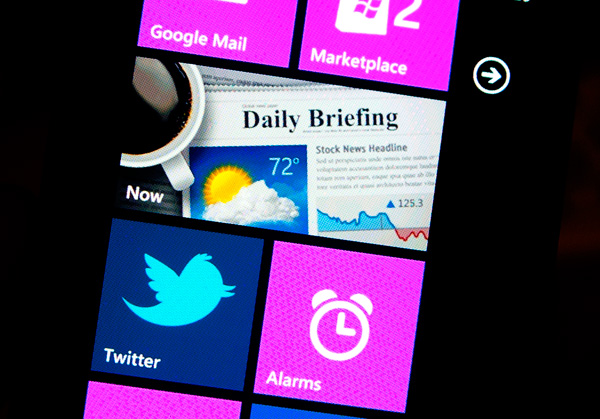
An example of an OEM installed app
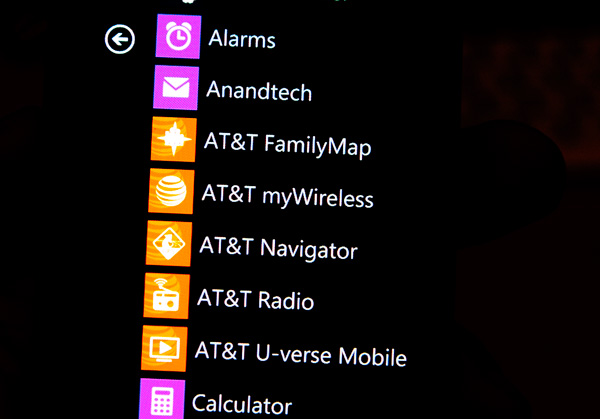
...and the list of AT&T installed apps on the Samsung Focus
The start screen is completely customizable. You can change the order of the tiles and remove any or all of them if you’d like. I found Microsoft’s start screen to be more useful than the default home screen on both Android or iOS. There’s less clutter and more of what you use most frequently is front and center. It’s like the left hand side of your Start Menu in Windows, except instead of automatically populating based on frequency of use it’s static. I suppose at some point we might see a more dynamic Start screen in Windows Phone. The only complaint I really have is that the camera tile isn’t there by default, but a quick pin later and all is well with the world.
The Windows Phone UI is built primarily to be used in portrait mode. While many apps will rotate to landscape, the intended use is in portrait. To deal with the obvious width limitations of a portrait phone, Microsoft made it very clear that nearly every app is wider than a single screen. While Android and iOS treat each screen as a discrete page, Windows Phone gives you a little preview of the next page to help convey the wider-than-visible UI. As far as how it works, the experience couldn’t be more natural. Virtually all apps implement this wide UI, including the start screen.
The start screen is the most traditional of multi-page UIs in Windows Phone. There’s a little animated arrow in the top right telling you that there’s more to be found at the next screen. Tap the arrow or flip the page and you’ll get to the second page of the Start screen: a list of all of your apps on the phone. There’s nothing more to it, just a simple list of everything on the phone. The GPU accelerated UI makes scrolling through the list super fast and smooth. And to be honest, a list of apps in alphabetical order is a lot simpler to navigate through than pages of app icons. I suppose eventually Microsoft may have to introduce another organization element to the app list (nested folders anybody?), but for now it works well.


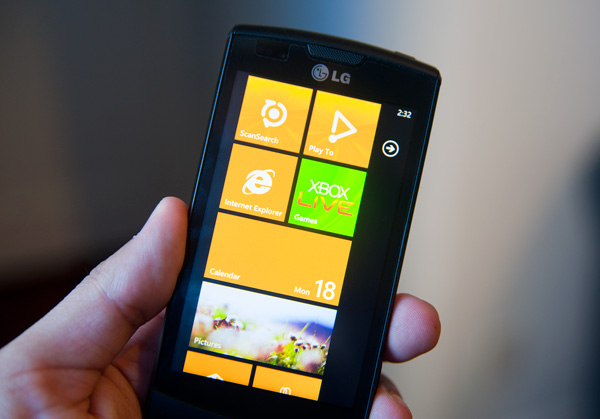

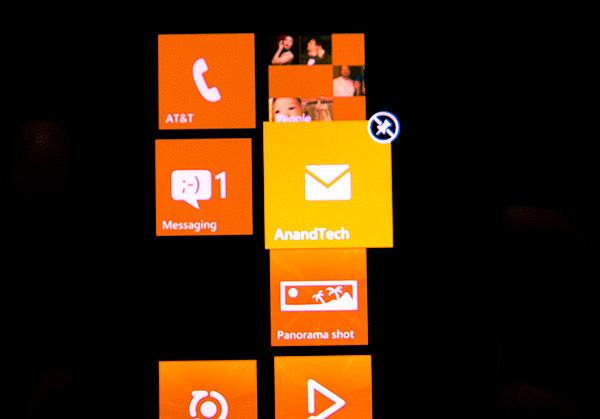

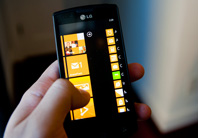
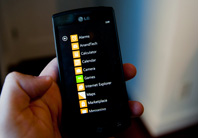








125 Comments
View All Comments
x0rg - Wednesday, November 3, 2010 - link
To me it looks like Microsoft just needed to release something ASAP. Later they can work on interface improvement, I mean fonts, sizes, blocks, text location, easy shortcut access, backups, etc. There are tons of things to improve.landswipe - Thursday, November 4, 2010 - link
"The downside to this layout is that every time you want to enter a different URL, you’ll have to rotate to portrait, enter it, and then swap back. Same if you want to change tabs or use a favorite. That can get a bit frustrating if you’re used to viewing pages in landscape, but not totally killer. There’s an impressively fluid rotation transition between portrait and landscape, however."Same theme through the whole article...
Little Upside... bit more downside... a little frustrated?... but HEY come on we are friends!!! there is some cool animation by our designers to make up for it all :D <cheesy grin>
It stinks of slight of hand, and overall sounds like an epic fail waiting to happen... This just won't compete.
As a developer, I don't think the apps/games produced are going to cut it... With Android and iPhone you can at least write cross platform opengl games in C++. dotNet is just pure lock-in.
I hope they sell just enough of these things to put an early end to it... I have a feeling a lot of people are going to get fooled.
jeans_xp - Sunday, November 7, 2010 - link
It's bad news for us, AMOLED is not used.www.mobilegoing.com
vhx - Tuesday, November 9, 2010 - link
Only problems I have are no custom ring tones (really now...). No messenger support yet. No clue about 3rd party apps, no one is talking about it. Will it be like Android or the tight control Apple has? I couldn't find any article talking about this.DKant - Saturday, November 13, 2010 - link
I got through 15 pages and that was it. I have already decided this is my next mobile-platform anyway (unless I start hearing rumors of a hologram-projecting iPhone 5), no point reading the remaining 200. I can't imagine the amount of patience it must have taken to WRITE this behemoth! :) Of course it's your job, you've been doing this forever etc, but still.Man, finally. A "proper" competitor to iOS, which was getting a little stale. And I have too many issues with Google's approach to consider any of the quadrillion models on offer.
Well. I do hope WP7 sells and lives longer than the Palm. :_(
(And I'd never imagined I'd finish a post with this..)
To Microsoft!!
CSMR - Saturday, November 13, 2010 - link
Very informative review, but shouldn't this site be serving people who are technically minded rather than the average consumer?There is no question WP7 has a lot of excellent points.
But I'm not sure how you can accept a system that does away with files, and uses a limited sync system to move content around in approved ways.
Or call software "The Best Smartphone for Music Lovers" when:
- it believes that music consists of "songs" written by "artists" and put into "albums", when only a minor part of the history of western music is of this form
- it does not allow a folder structure for navigation, only limited tags of the above form
- gapless playback is incomplete
Microsoft needs prodding to update the system in a way that retains the new features and GUI but also implements the basic features. If it doesn't get this from tech sites, where are we left? Perhaps Windows 8 will decide Turing completeness is no longer important, people just need to be able to do x, y, and z as simply as possible. I'm sure there are a lot of people at Microsoft who want WP7 to be a real OS - without changing usability. They just need a bit of support.
Millsington - Tuesday, November 16, 2010 - link
Excellent point about folder navigation, I had forgotten about that. It is sorely missed in modern music players.Sadly, I don't see the issues you raised being addressed for some time unless WP7 really takes off.
billybarker - Tuesday, November 16, 2010 - link
Check out these Windows Phone 7 Application Icons - there are 350 icons in the set. http://goo.gl/rMk08warden6 - Friday, November 19, 2010 - link
I've had my HTC 7 Mozart for a fortnight. I like it. I like the big square icons on the Start screen (although I've toned down the colour as much as possible); I like the integration with Google Mail, Contacts and Calendar (yes it does work, set it up as an Exchange server); I like the threaded conversations for texts like the iPhone; the music player is good; oh, and it's not a bad phone either.There are some issues -- there's no Messenger client, gapless track playback is haphazard to say the least, there's a limited range of alerts/ringtones and you can't add more, and battery life is a bit short. Especially with push email. Hopefully some of those can be fixed, but they're definitely not deal-breakers for me.
What I can't figure out is how to do "Inverse" on the scientific view of the calculator. No inverse-sin, inverse-log, etc. That's not a deal-breaker either, I don't use those very often! But it's an odd omission.
anistoona - Sunday, November 21, 2010 - link
" but while home I don’t use those apps as much. Instead my smartphone behaves more like an SMS, phone, email, camera and web browsing device, and it’s in those areas that Windows Phone is easily just as good as the competition."With all my respect: If I need only the SmS, phone, email, Camera and web borwisng things form my handheld device, I would like to buy a 150$ Symbian phone, I don't need to buy an up to 700$ smartphone to do that things!!
WinMob 5, 6.x was the system which puts the definition of what " Smart Phones" should capable of, and disappointingly Microsoft chose to give up that system and replaced with a modified copy of Old, aged and discontinued competitors system ( I mean first generation of iOS ) ..
Really good choice Microsoft !